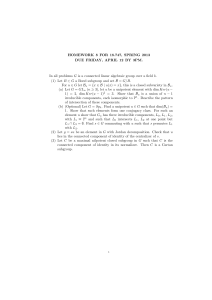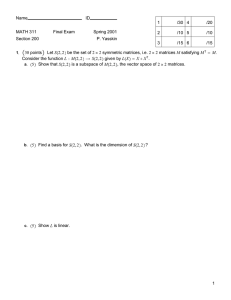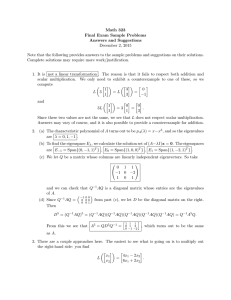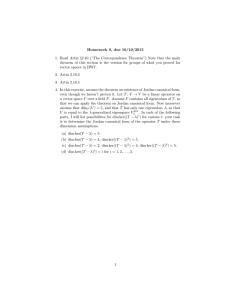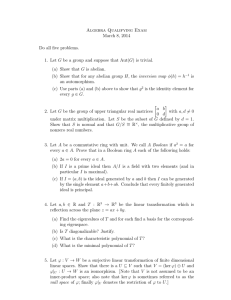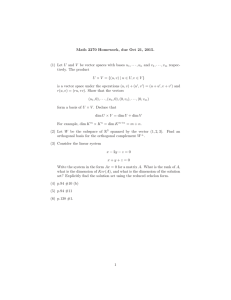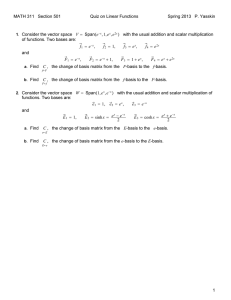Mathematics 2270 Homework 6-Sketch of solutions Fall 2004
advertisement
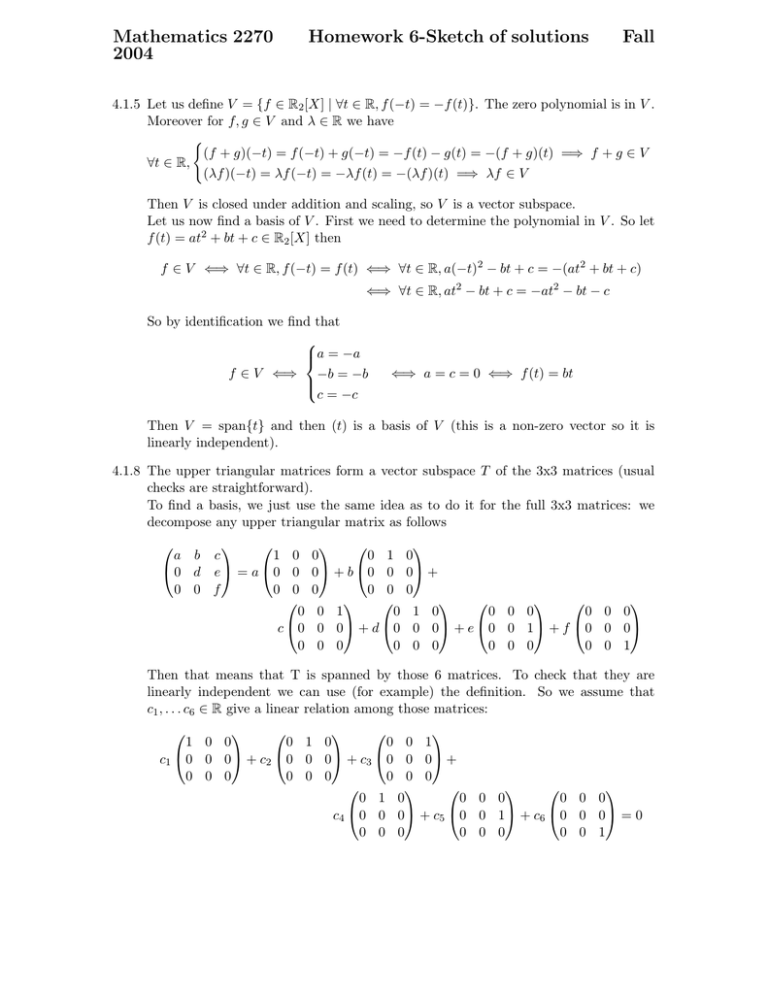
Mathematics 2270
2004
Homework 6-Sketch of solutions
Fall
4.1.5 Let us define V = {f ∈ R2 [X] | ∀t ∈ R, f (−t) = −f (t)}. The zero polynomial is in V .
Moreover for f, g ∈ V and λ ∈ R we have
(
(f + g)(−t) = f (−t) + g(−t) = −f (t) − g(t) = −(f + g)(t) =⇒ f + g ∈ V
∀t ∈ R,
(λf )(−t) = λf (−t) = −λf (t) = −(λf )(t) =⇒ λf ∈ V
Then V is closed under addition and scaling, so V is a vector subspace.
Let us now find a basis of V . First we need to determine the polynomial in V . So let
f (t) = at2 + bt + c ∈ R2 [X] then
f ∈ V ⇐⇒ ∀t ∈ R, f (−t) = f (t) ⇐⇒ ∀t ∈ R, a(−t)2 − bt + c = −(at2 + bt + c)
⇐⇒ ∀t ∈ R, at2 − bt + c = −at2 − bt − c
So by identification we find that
a = −a
f ∈ V ⇐⇒ −b = −b
c = −c
⇐⇒ a = c = 0 ⇐⇒ f (t) = bt
Then V = span{t} and then (t) is a basis of V (this is a non-zero vector so it is
linearly independent).
4.1.8 The upper triangular matrices form a vector subspace T of the 3x3 matrices (usual
checks are straightforward).
To find a basis, we just use the same idea as to do it for the full 3x3 matrices: we
decompose any upper triangular matrix as follows
a b c
1 0 0
0 1
0 d e = a 0 0 0 + b 0 0
0 0 f
0 0 0
0 0
0
0 0 1
c 0 0 0 +d 0
0
0 0 0
0
0 +
0
0 0 0
0 0 0
1 0
0 0 + e 0 0 1 + f 0 0 0
0 0 1
0 0 0
0 0
Then that means that T is spanned by those 6 matrices. To check that they are
linearly independent we can use (for example) the definition. So we assume that
c1 , . . . c6 ∈ R give a linear relation among those matrices:
0
0 1 0
1 0 0
c1 0 0 0 + c 2 0 0 0 + c 3 0
0
0 0 0
0 0 0
0 1
c4 0 0
0 0
0 1
0 0 +
0 0
0 0 0
0 0 0
0
0 + c5 0 0 1 + c6 0 0 0 = 0
0 0 1
0 0 0
0
but the this is equivalent to
c1 c2 c3
0 0 0
0 c4 c5 = a 0 0 0 ⇐⇒ c1 = · · · = c6 = 0
0 0 c6
0 0 0
then those matrices are linearly independent, then they form a basis of T .
4.1.58 a) g ∈ V then
(g 2 + (g 0 )2 )0 = 2gg 0 + 2g 0 g 00 = 2(gg 0 − gg 0 ) = 0 as g 00 = −g
so the function g 2 + (g 0 )2 is constant.
b) g ∈ V and g(0) = g 0 (0) = 0. Then from a) we know that the function g(x)2 +
(g 0 (x))2 = c where c is a constant. But for x = 0 we have
c = g(0)2 + (g 0 (0))2 = 0 as we assumed g(0) = g 0 (0) = 0
then for all x we have g(x)2 + (g 0 (x))2 = 0 but this implies that for all x, g(x) = 0.
c) f ∈ V . We define g(x) = f (x) − f (0) cos x − f 0 (0) sin x. We calulate
g 0 (x) = f 0 (x) + f (0) sin x − f 0 (0) cos x =⇒ g 00 (x) = f 00 (x) + f (0) cos x + f 0 (0) sin x
= −f (x) + f (0) cos x
= −g(x)
then g ∈ V . Moreover you check that g(0) = g 0 (0) = 0 so applying b) we have that
for all x, g(x) = 0. But this means that
∀x ∈ R, f (x) = f (0) cos x + f 0 (0) sin x
Then V = span{cos, sin}.
4.2.53 We first compute ker T . Let f (t) = at2 + bt + c ∈ R2 [X], then
f ∈ ker T ⇐⇒ T (f ) = 0 ⇐⇒ ∀t ∈ R, f 00 (t) + 4f 0 (t) = 0
⇐⇒ ∀t ∈ R, 2a + 4(2at + b) = 0
⇐⇒ ∀t ∈ R, 8at + 4b + 2a = 0
⇐⇒ 8a = 0 and 4b + 2a = 0 ⇐⇒ a = b = 0 ⇐⇒ f (t) = c
Then ker T = {c | c ∈ R}, that is the kernel of T is the set of all constant polynomials.
A basis of ker T is the f (t) = 1 (the constant polynomial equal to 1). Then dim ker T =
1, and using rank-nullity we have
rank T = dim R2 [X] − dim ker T = 2
Now we can remark that Im(T ) ⊂ R1 [X] (the polynomials of degree 1 or less) as for
all f ∈ R2 [X] we have
deg(T (f )) = deg(f 00 + 4f 0 ) ≤ max{deg f 00 + deg f 0 } = max{deg f − 2, deg f − 1} ≤ 1
as deg f ≤ 2. But we know that dim R1 [X] = 2 = dim Im(T ) then Im(T ) = R1 [X].
4.2.63 dim R3 = 3 and dim R3 [X] = 4 so there is no isomorphism between them (otherwise
they would have the same dimension).
4.2.73 We first remark that Zn = {an tn + · · · + a1 t | an , . . . , a1 ∈ R}. So a basis of Zn
is given by (t, t2 , . . . , tn ). Indeed they span Zn and we already know that they are
linearly independent. This also proves that dim Zn = n = dim Rn−1 [X]. So T is an
isomorphism iff ker T = {0}. Let us compute it. Let f (t) = an−1 tn−1 + · · · + a1 t + a0 ∈
Rn−1 [X],
f ∈ ker T ⇐⇒ T (f ) = 0 ⇐⇒ ∀t ∈ R,
t
f (x)dx = 0
0
an−1 n
an−2 n−1
a1
t
+ · · · + t2 + a 0 t = 0
n
n−1
2
= an−2 = · · · = a1 = a0 = 0 ⇐⇒ f = 0
⇐⇒ ∀t ∈ R,
⇐⇒ an−1
Z
t +
then ker T = {0}, then T is an isomorphism.
4.2.74 You can check that the differential map gives an isomorphism between Zn and Rn−1 [X]:
D : Zn → Rn−1 [X]
f 7→ f 0
4.2.76 Using the linearity of T we have
T (0V + 0V ) = T (0V ) + T (0V )
but 0V + 0V = 0V (neutral element of + in V ) then we have T (0V + 0V ) = T (0V ) and
then
T (0V ) + T (0V ) = T (0V ) =⇒ T (0V ) = 0W
to obtain the last equality we have “simplified” by T (0V ), that is we have added its
opposite to both members of the equation.
